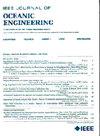Few-Shot Underwater Acoustic Target Recognition Using Domain Adaptation and Knowledge Distillation
IF 3.8
2区 工程技术
Q1 ENGINEERING, CIVIL
引用次数: 0
Abstract
The complex dynamics of the marine environment pose substantial challenges for underwater acoustic target recognition (UATR) systems, especially when there are limited training samples. However, existing image-based few-shot learning methods might not be applicable, mainly because they fail to capture the temporal and spectral features from acoustic targets and lack the competent domain adaptation ability due to the inefficient usage of base samples. In this article, we develop a novel Domain Adaptation-based Attentional Time–Frequency few-shot recognition method (DAATF) for underwater acoustic targets. The DAATF explicitly utilizes a self-attention-based feature extractor to capture the time–frequency structural dependencies and constructs an autoencoder-based domain adapter to improve the cross-domain knowledge transfer through reusing the base dataset. In addition, a knowledge distillation module is designed to enable the model to reserve the general feature extraction ability of the pretrained network to avoid overfitting. Extensive experiments are conducted to assess prediction accuracy, noise robustness, and cross-domain adaptation. The obtained results validate that the DAATF can achieve outstanding performance, demonstrating its great potential for practical UATR applications. Furthermore, we provide free and open access to the DanShip data set.基于领域自适应和知识精馏的水声小目标识别
海洋环境的复杂动态给水声目标识别(UATR)系统带来了巨大的挑战,特别是在训练样本有限的情况下。然而,现有的基于图像的少镜头学习方法可能并不适用,主要原因是它们不能捕获声目标的时间和光谱特征,并且由于基础样本的低效使用而缺乏有效的域适应能力。本文提出了一种基于域自适应的水声目标注意时频少弹识别方法。DAATF明确地利用基于自关注的特征提取器捕获时频结构依赖关系,并构建基于自编码器的领域适配器,通过重用基础数据集来提高跨领域知识转移。此外,设计了知识蒸馏模块,使模型保留预训练网络的一般特征提取能力,避免过拟合。进行了大量的实验来评估预测精度、噪声鲁棒性和跨域适应性。实验结果表明,DAATF具有优异的性能,在实际UATR应用中具有巨大的潜力。此外,我们提供对DanShip数据集的免费开放访问。
本文章由计算机程序翻译,如有差异,请以英文原文为准。
求助全文
约1分钟内获得全文
求助全文
来源期刊

IEEE Journal of Oceanic Engineering
工程技术-工程:大洋
CiteScore
9.60
自引率
12.20%
发文量
86
审稿时长
12 months
期刊介绍:
The IEEE Journal of Oceanic Engineering (ISSN 0364-9059) is the online-only quarterly publication of the IEEE Oceanic Engineering Society (IEEE OES). The scope of the Journal is the field of interest of the IEEE OES, which encompasses all aspects of science, engineering, and technology that address research, development, and operations pertaining to all bodies of water. This includes the creation of new capabilities and technologies from concept design through prototypes, testing, and operational systems to sense, explore, understand, develop, use, and responsibly manage natural resources.
 求助内容:
求助内容: 应助结果提醒方式:
应助结果提醒方式:


